When it comes to data analytics and workflow automation, the right tool can significantly affect your productivity and the quality of your results. However, choosing the right tool is easier said than done given that there are many options available in the market. Two of the most popular tools in the ETL (Extract, Transform, Load) domain are KNIME and Alteryx. Both of them offer a visual, drag-and-drop interface for creating data workflows, but they also have some pretty significant differences that you may want to consider before arriving at a decision.
In this blog, we will compare KNIME and Alteryx in terms of their features, strengths, weaknesses, and use cases to help you make an informed choice. Plus, we will also show you how to migrate your workflows from one tool to another in case you decide to switch. By the end of this post, you will have a clear understanding of which tool is best suited for your data analytics needs.
KNIME or Alteryx which to choose from
Alteryx or KNIME?
Key differences KNIME and Alteryx
Data visualization in KNIME and Alteryx
KNIME vs Alteryx which is better?
KNIME – An Open-Source Powerhouse
KNIME, short for Konstanz Information Miner, is an open-source data analytics platform that provides a visual, drag-and-drop interface for building data workflows. It is known for its flexibility, scalability, and strong community support. KNIME allows users to integrate various data sources, perform data preprocessing, apply machine learning algorithms, and visualize results – all within a single environment. It supports multiple programming languages, including Python and R, which makes it a versatile choice for data professionals.
Alteryx – A Commercial Data Analytics Leader
Alteryx is a commercial data analytics platform designed for data blending, advanced analytics, and data science. It offers a user-friendly interface for data preparation and analytics, enabling users to create complex workflows easily. Alteryx focuses on self-service data analytics, making it accessible to business analysts and data professionals. While it’s a paid solution, it comes with a comprehensive set of features and support.
KNIME v/s Alteryx
Let’s dive deeper into the key differences between KNIME and Alteryx to help you understand which aligns better with your needs.
| Aspect | KNIME | Alteryx |
| Licensing Model | Open source with a free community edition and a subscription-based enterprise edition | Commercial, subscription-based offering with a free 30-day trial period |
| Data Preparation | Offers data cleaning and transformation tools | Renowned for its data preparation capabilities |
| Integration | Supports various data sources and formats | Integrates seamlessly with external systems |
| Scalability | Limited scalability for large datasets | Scalable, designed for handling large datasets |
| Community Support | Thriving user community with extensive resources | Robust user community with excellent support |
| Flexibility | Highly flexible and supports custom workflows | Flexible but may require workarounds for specific needs |
| Performance | Suitable for small to medium size datasets | Scalable, designed for big data analytics |
| Advanced Analytics and Machine Learning | Offers a wide range of ML algorithms and tools | Proficient in data preparation and less ML-focused |
| Ease of Use | Learning curve for advanced features | User-friendly interface for non-technical users |
| Security | Limited built-in security features | Offers data encryption, access controls, and auditing |
| Extensions & Plugins | Extensive open-source options and extensions | Fewer open-source options; commercial extensions |
| Output | KNIME offers a variety of output formats like CSV, excel, Database export (e.g., MySQL, Oracle), Tableau Data Extract files (TDE) | Alteryx offers many ways to save work like CSV, excel, Database export (e.g., MySQL, Oracle), Tableau Data Extract files (TDE), Spatial Output (ESRI Shapefiles, KML) |
Key Differences
Security: Alteryx has a clear advantage in security, with built-in features for data encryption, access controls, and auditing. This makes it a robust choice for organizations with stringent security requirements. KNIME, on the other hand, may need additional configurations and third-party tools to achieve similar security levels.
Usability: Alteryx is renowned for its user-friendliness, especially in data preparation tasks. In contrast, while KNIME provides immense flexibility, it may require scripting or programming knowledge for advanced features.
Scalability: Alteryx is designed to handle large datasets and complex workflows efficiently, making it suitable for organizations dealing with substantial data volumes. KNIME may not perform as well with large datasets and complex operations, primarily relying on a single machine.
Flexibility: KNIME offers greater flexibility due to its open-source ecosystem and extensive community-contributed plugins. Alteryx provides flexibility but may require workarounds for specific use cases due to its commercial nature.
Integration: KNIME is highly extensible and supports a wide range of data connectors, making it suitable for integrating with various data sources and tools for example – Excel, CSV, JSON, Cloud: Amazon Web Services, Microsoft Azure, Google Cloud, Databricks Big Data file systems: Apache Hadoop, Apache Hive Google BigQuery, Amazon Redshift. Alteryx too offers integrations but may not be as flexible as KNIME when it comes to working with different data platforms like Excel, CSV, JSON, Access, Cloud (Amazon S3, Google Cloud Storage, Microsoft Azure Blob Storage),and Big Data file systems (Apache Hadoop, Hive, Spark).
Knime
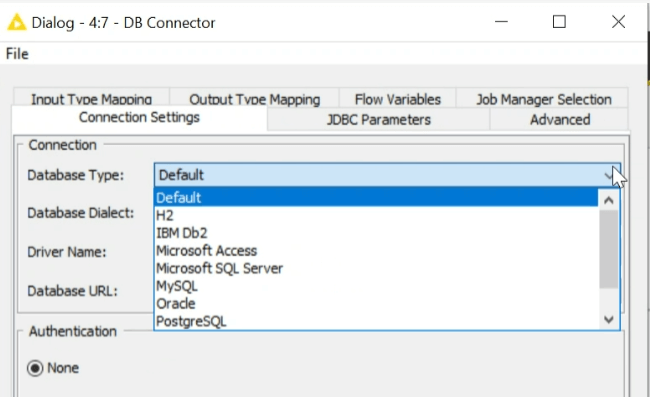
Alteryx
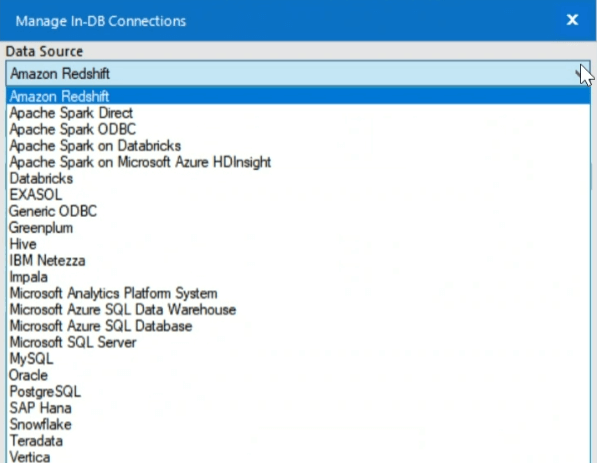
Advanced Analytics and Machine Learning: KNIME provides a wide range of machine learning algorithms and integrations with popular ML libraries like scikit-learn, TensorFlow, and XGBoost. It also has an active community and marketplace with numerous extensions and integrations. While Alteryx also has machine learning capabilities, it may not offer as wide a range of ML algorithms and integrations as KNIME. However, Alteryx provides a robust set of tools for data preparation, which is often a critical step in the machine-learning pipeline.
Workflow Migration – From Alteryx to KNIME
One of the critical aspects of transitioning between tools is the ability to migrate workflows seamlessly. Let’s take a look at the process of migrating a workflow from Alteryx to KNIME.
Alteryx Workflow: For Example, we have taken here a sample Alteryx workflow and migrated it to KNIME.
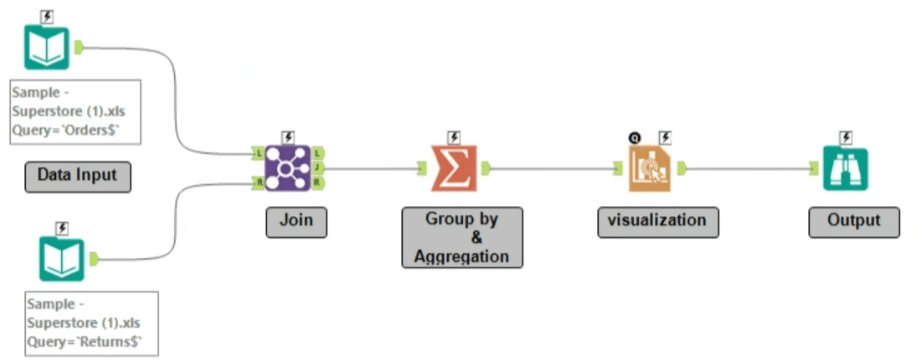
Migration Steps:
- Open your Alteryx workflow in Alteryx Designer.
- Examine the workflow’s structure, operations, and data inputs/outputs.
- Recreate in KNIME:
- In KNIME, use the “File Reader” node to read the desired file or use the DB Connector to connect with the desired data source.
- Utilize various KNIME nodes (e.g., “Data Cleaning,” “Aggregation”) to replicate data preparation and aggregation steps.
- Connect nodes in the desired order.
- Execute the KNIME workflow to ensure it produces the same results as the Alteryx workflow.
Below is the sample migrated KNIME workflow.
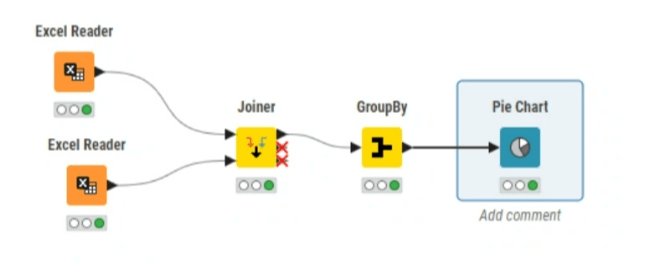
Data Visibility
Both KNIME and Alteryx offer data visualization capabilities to help you communicate insights effectively.
KNIME provides data visualization tools within its platform, allowing you to create a wide range of charts and graphs to visualize your data. It offers interactive visualization options.
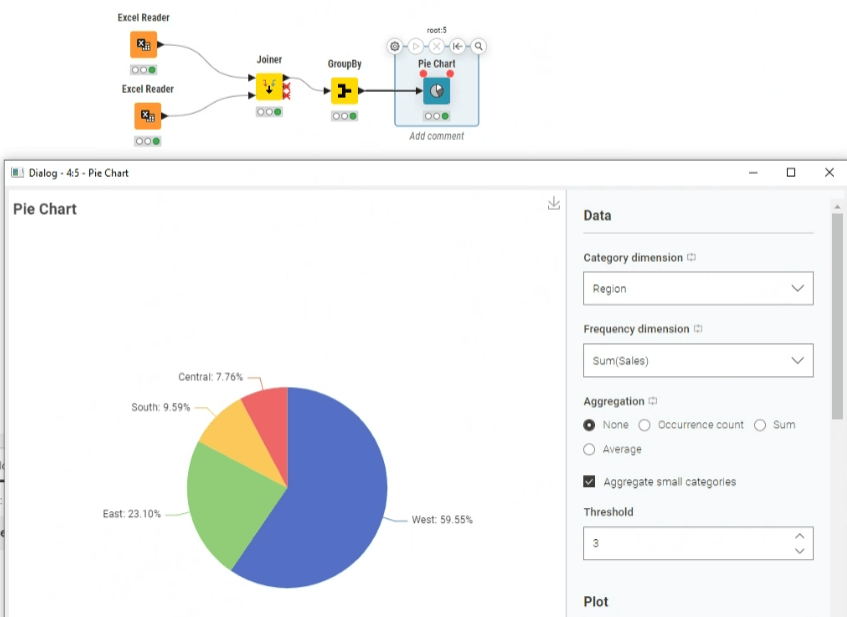
Alteryx has basic visualization capabilities, primarily focused on data preparation and transformation.
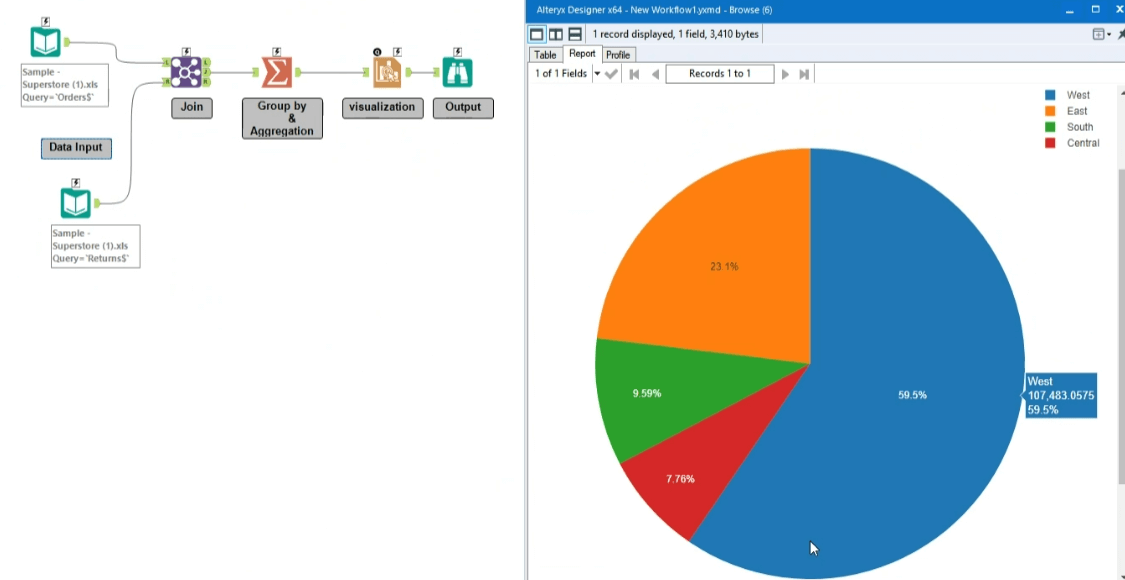
Conclusion
Choosing between KNIME and Alteryx ultimately depends on your specific requirements and budget. In our view, you should choose KNIME when you need an open-source, flexible solution with advanced machine-learning capabilities. KNIME is suitable for organizations with data science teams and a willingness to invest time in customization.
However, if user-friendliness, data preparation, and scalability is what you are looking for, we recommend Alteryx. Alteryx excels in data cleansing and transformation and is ideal for non-technical users. It’s also well-suited for organizations dealing with large datasets.
In the end, both KNIME and Alteryx are capable data analytics platforms, and your decision should align with your unique needs and circumstances. Whichever you choose, both tools have the potential to empower you and your organization in making data-driven decisions and extracting valuable insights from your data.
Thanks for reading!



